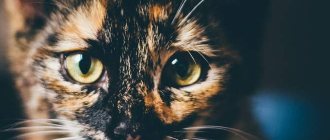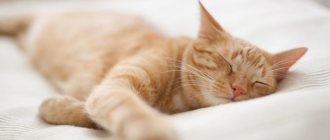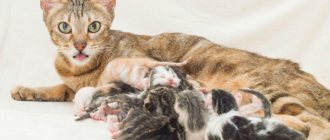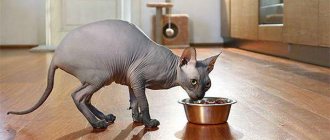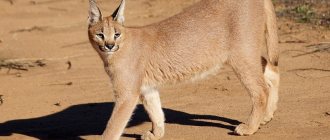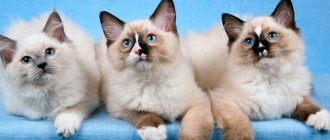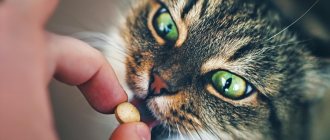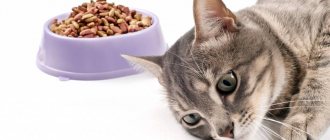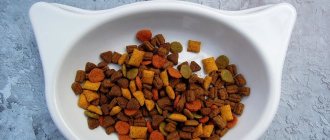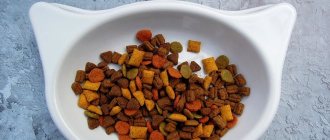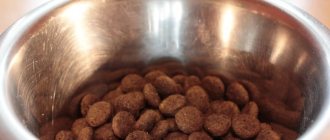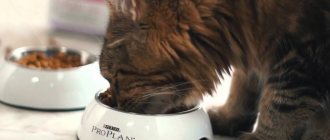The health of cats, like any pet, depends entirely on the care of the owner and his knowledge regarding the rules of keeping and feeding habits of the pet. By studying specialized literature and using the recommendations of veterinarians, you can choose the right optimal diet and understand how to feed your cat.
Principles of organizing a proper diet
If the owner has doubts about when and how often to feed the pet, it is worth adopting several techniques for optimally organizing cat dinners, which are recommended by veterinary experts.
Following these rules will help avoid digestive problems and protect against the development of obesity:
- Two feedings throughout the day is the answer to the question of how many times a day you need to feed your pet kitty. It is preferable to do this in the morning and evening. Please note that an adult cat should be fed according to this regimen. A small kitten should be fed five to six times during the day. They are transferred to two meals a day after six months of life.
- Feeding at the same hours. This rule disciplines the cat; he does not get used to begging from the master's table.
- Limiting feeding time. It takes a cat 20 minutes to satisfy his hunger and get enough. If during this time he has not eaten all the food, it is still better to remove the bowl of food. This will help avoid unnecessary overeating. If the cat begins to lazily eat the rest of the food, it means that he is already full enough.
- Single serving limit. You should not add a daily portion of food at one feeding.
Regardless of the time and number of feedings, fresh water should always be fully available to the cat.
Making up a diet
It is important that your cat's diet contains sufficient nutrients. But remember that their excess is just as harmful as their deficiency. Proper absorption also depends on the form in which they enter the body. To create the right diet, you need to take into account the individual needs of your pet. Size, age, lifestyle and special health needs matter. It is best to entrust the choice to professionals.
When creating PRO PLAN® food, knowledge and many years of experience in the field of nutrition are used, taking into account the needs of animals of different ages and health conditions. The developed products contain all the necessary nutrients in an easily digestible form. Different tastes allow you to accommodate the needs and preferences of even the most selective cats.
Cat diet in numbers
Feeding standards for cats depend on many factors:
- age;
- gender;
- size and weight;
- breeds;
- health conditions;
- lifestyle;
- type of food - dry, canned, natural products;
The question may arise: does the number of feedings depend on calorie content? Depends directly. This is one of the most important factors that determine the size of portions and their quantity throughout the day.
A cat will need more food if its food is low in nutritional value. It is better to choose a diet that, without compromising health, will satisfy the needs of twice feeding, morning and evening. It is better to choose a higher nutritional value over the amount of feed.
The optimal calorie content of the daily diet should be about 70 kcal per 1 kg of weight. Depending on the calorie content, the weight in grams of the daily norm is determined at the rate of 30-60 g per kg of the cat’s weight and is about 250 g.
Thus, an adult, healthy cat weighing 5 kg can eat 250 g of food per day with a total calorie content of 350 kcal.
Cats have a high need for amino acids. The meat and protein component in their diet is preferable to vegetables or cereals. Carbohydrates in the daily amount of feed should be no more than 3%, fats - no more than 15%.
Energy and nutrients
The main value of the diet is the nutrients necessary for the health of the animal.
- Proteins
(proteins) play an important role in most life processes. They are necessary for healthy growth, muscle formation, and proper development of the body. Responsible for immunity and blood cell production. Kittens and pregnant cats have an especially great need for proteins - this element helps bear fruit and ensure proper development of babies before and after birth. - Carbohydrates
are a source of energy. According to FEDIAF, cats do not need a high carbohydrate diet; they are able to synthesize glucose from animal proteins. But the presence of carbohydrates in the diet maintains the health of the digestive system and the entire body. They promote energy production, increase activity and promote a feeling of fullness. - Lipids
(fats) are organic substances necessary for energy production. They help absorb fat-soluble vitamins and serve as a source of polyunsaturated fatty acids. A deficiency of lipids in the diet leads to deterioration of the skin and coat, and reproductive dysfunction. - Minerals
(macroelements and microelements) are involved in the formation of bones and cartilage tissue, and maintain skin health. They also maintain the ionic balance of cells and promote hemoglobin synthesis. Necessary for the health of the thyroid gland, they function as antioxidants. - Vitamins
are involved in many vital processes. They participate in the formation of blood cells, the synthesis of hormones, and the regulation of metabolic processes in the body. They have an antioxidant effect, affect the health of the skin and coat, and the secretion of skin secretions. It is especially important to ensure the supply of vitamins A and D: cats’ bodies do not produce them.
Meat, fish, and cottage cheese are rich in proteins.
The source of carbohydrates is grains, vegetables and fruits.
Lipids are found in meat (beef), dairy products, eggs.
Contained in meat, fish, cereals and legumes.
Meat, grains, dairy products, fish oil, fruits and vegetables are rich in vitamins.
It is important to consider that the nutrients and vitamins from the listed products are not completely absorbed by the cat’s body, and some natural products can cause digestive upset. The composition of industrial feeds takes into account all the animal’s needs for micro- and macroelements and “supplies” them to the body in an accessible and easily digestible form.
Reasons for adjusting average standards
There are several nuances that affect these numbers:
- a cat eats more food than a cat;
- more high-calorie food is necessary for an animal with high activity;
- after giving birth, the cat needs to be fed as many times a day as she asks;
- large breeds of cats also need to increase the average standards;
- Some cat breeds are prone to metabolic disorders. For them, dry food that is more balanced in composition is preferable;
- To maintain good reproductive function, a purebred stud cat must eat food with a high content of vitamin E.
When an animal begins to beg for food between set feedings and exhibit uncontrolled apatite, this may be a signal of parasite infection. Pets must be given deworming medications regularly.
To make sure your cat is getting enough food and has not lost or gained too much weight, regular weighings are recommended. If the indicators go significantly beyond the limits, it is necessary to reconsider the diet, its type, composition, and calorie content. The optimal average weight for most breeds is 2-4.5 kg.
Incorrect dosage: problems associated with overfeeding
Sometimes owners, seeing the animal’s excellent appetite, cannot resist giving it an additional portion of food. Let's face it, it's very difficult to resist such a reaction. It’s even more difficult not to throw a piece of chicken (fish, minced meat) to your pet when he’s spinning under his feet and wondering: what is that they’re cooking there? Believe me, this kind of love kills. And if you want the best for your cat, don't overfeed it.
Obesity in cats is often associated with poor quality nutrition. We have already written a lot about this, so we’ll just remind you: economy-class food contains a lot of fat and carbohydrates, but little protein. This leads to an imbalance of the food supply, problems with metabolism and, at a minimum, excess weight of the pet. Possible problems are not limited to this: from poor nutrition, an animal can develop pancreatitis, urolithiasis, and diabetes.
Therefore, we assume that you have long since transferred your cat to a high-quality “holistic” cat, but still notice some rounding of the pet. What to do about it?
To get started, ask yourself a few simple questions: Is your cat overweight? Does your pet constantly ask for more and beg? Do you have problems with your fur or skin?
All this may indicate an incorrect dosage of food. By the way, the fact that the cat constantly asks for food does not mean that you are not feeding it. Perhaps she is simply accustomed to larger than normal portions, and her appetite, as we know, comes with eating. In the United States, studies are regularly conducted regarding excess weight in pets. This problem is so serious that the Association for the Prevention of Pet Obesity was created in 2005. And as of 2022, more than 58 percent of cats were overweight or obese to varying degrees.
We think that there is no need to explain what the excess weight of a pet entails. These include problems with the gastrointestinal tract, increased stress on the joints, and in the long term – a reduction in life expectancy. But what to do if the food is given in strict accordance with the instructions on the package, and the cat keeps getting fatter and fatter?
Norms for kittens by month of life
The decision on how many times a day to feed a kitten depends on the baby's age in months. During growth and development, the cat's body requires more feedings throughout the day.
From birth and during the first month
If a newborn kitten is separated from its mother for any reason, then the responsibility of feeding the kitten falls on the shoulders of the person. If you couldn’t find another cat that could feed you with its own milk, you should feed the kitten without a mother a special formula. You can use infant formula for newborns.
It is forbidden to give a newborn kitten whole cow's milk in the first month of life; this is a very heavy food.
To develop the sucking reflex, it is advisable to use a bottle when feeding. You can try feeding from a pipette.
During the first three days you need to feed every two hours, including at night. Then, by the 10th day of life, the interval between feedings is increased to 4 hours. For the first two weeks, the daily intake of formula for a kitten is 30-40 ml per 100 g of baby’s weight.
A one-month-old kitten should be fed exclusively with formula, increasing its volume to 50-55 ml per 100 g of weight by day 30. Then start feeding him adult food.
1-2 months
The age of a kitten from a month to two months is the time to accustom it to food in pieces. By the end of the second month, the kitten should eat about 200 g of food, which is divided into 5 feedings. You can offer him oatmeal or rice milk porridge with the addition of a chicken egg. If ready-made food does not cause digestive upset, then you can completely switch the kitten to natural feeding.
2-3 months
A 2 month old kitten needs to be fed 4 times a day. He can already eat about 300 g of food, cut into small pieces. For example, you can offer minced meat.
3-4 months
A 3 month old kitten needs to be fed 3 times a day. The total volume of food eaten is approximately 360 g. Until this age, pieces of dry food must be soaked in water when feeding. At 3 months, kittens change their teeth and can already be introduced to solid food.
4 months and older
By this time, the kitten’s menu should consist of 75% meat protein foods.
Under no circumstances should you feed your kitten raw or fresh meat. This threatens protein intoxication or infection with parasites.
By six months, you can gradually transfer the grown kitten to two meals a day.
Harmful and dangerous products
Cats can distinguish far fewer tastes than humans, so they don't need much variety. They do not distinguish sweet taste at all, salty - weakly. Bitter food is instinctively perceived as unpalatable: many natural poisons have this taste. But the sour taste is perceived as pleasant. Human food may seem tasty to a cat, but many foods from the owner's table are harmful to the cat, and some are dangerous to its health and even life.
Avocado
Causes diarrhea and vomiting due to its persin content.
Onions and garlic
lead to sulfoxide poisoning, leading to anemia.
Grapes and raisins
- to kidney damage.
Macadamia
nuts can cause severe intoxication, leading to convulsions and paralysis of the limbs.
Eating yeast dough
causes bloating.
It is strictly forbidden to allow your cat to try alcohol
and
chocolate
.
Even in small quantities they lead to life-threatening poisoning. Constant consumption of liver
causes an excess of vitamin A, which is no less dangerous than vitamin deficiency.
Spicy, fried and fatty foods are harmful to your cat's health. You cannot treat your animal to sausage, frankfurters, canned meat and fish because of the salt and spices they contain. It is not advisable to give tubular bones after heat treatment: they become brittle, and when they are chewed, sharp fragments are formed that are dangerous to the body.
Nutrition for cats during special periods of life
The measured life of domestic cats changes greatly in some periods.
Illnesses and injuries, pregnancy, surgery, old age - all such changes in health require adjustments to the usual diet.
For example, nursing cats need more high-calorie food because their energy needs increase significantly. During the period of feeding kittens with milk, the volume of the daily diet should be increased, its nutritional value should be higher.
After sterilization or castration surgery, metabolism slows down in male cats. Therefore, their energy needs are reduced by approximately 25%. Appetite, on the contrary, may increase due to the lack of stress and dulling of the reproductive instinct. The owner should take these features into account in the postoperative period.
When preparing a diet for an animal after sterilization, you should give preference to low-calorie food. You can also feed a sterilized or neutered cat twice a day.
One should take into account the fact that after such an operation the frequency of urination decreases and the risk of developing urolithiasis increases. To avoid this, it is better to feed castrates with specialized food. Conventional food contains a lot of salt. This threatens the formation of kidney stones.
A sick cat usually needs a special diet, which is prescribed by a veterinarian. In especially severe cases, the animal has to be force-fed. After recovery and restoration of appetite, they return to their previous diet.
Elderly and aging cats' teeth deteriorate and other oral problems arise. Reviewing the cat's diet in this case is also very important. For example, replace dry food with canned food or introduce liquid natural dishes into the menu. You can leave only one feeding during the day. The optimal solution would be to reduce portions and increase the number of feedings. The diet of older animals should contain up to 10% carbohydrates.
Food allowance for an old cat
From 7/8 years old our animal will change from an adult cat to a senior cat and as a result their ability to digest proteins and fats will decrease. Therefore, it is necessary to continue to feed them 2 servings per day, but with high-quality and easily digestible food.
In addition to their ability to digest, we will notice other changes in our pet, such as the quality of the coat (less shiny). Or the amount of daily physical activity that makes them less active and energetic. However, this process is inevitable, but we can significantly extend the life of our companion if we feed him in a way that is appropriate for his age.
Industrial feed: pros and cons
Industrial animal feeds are divided into two types:
- wet food - canned food in the form of pates, pieces of meat with sauce;
- dry granulated food - small crackers.
Feeding natural food will require a lot of knowledge, patience and time. With skillful preparation of a correct and balanced menu, such nutrition will be healthier and safer.
Ready-made food has its advantages and disadvantages compared to natural food.
Industrial feed is better for several reasons:
- contains a complete balance of essential vitamins and microelements;
- easy to calculate and control the size and number of servings;
- long shelf life;
- feeding with dry food is more convenient;
- the opportunity to choose specialized veterinary food that meets the needs of a cat with health conditions.
Cats that eat only dry food must always have fresh water available.
Disadvantages of using industrial feed:
- high cost of quality feed;
- In canned food with sauce, more than half of the volume is water. Satiety with such food is reduced;
- high salt content, which threatens the development of urolithiasis;
- This food is addictive. It becomes very difficult to switch a cat to a different diet.
When feeding with ready-made store-bought food, you should pay attention to the mark indicating whether any type of food is complete. It can only serve as an additive to the main diet and does not satisfy all the nutritional needs of the cat.
When combining dry food with canned food, it is better to stick to the proportion - about 70% dry food and 30% canned food.
Some artificially bred cat breeds are susceptible to allergies and metabolic disorders. To maintain health, it is recommended to feed them only with fully balanced ready-made special food.
Basic principles of feeding at home
In nature, a cat is a predator. She catches small animals and birds and eats them whole, along with the contents of the stomach, wool and a small amount of feathers. The basis of the diet is meat, which is best digested raw. Plant foods should not form the basis of the diet: the cat’s body does not need large amounts of carbohydrates, and also does not digest coarse-fiber carbohydrates and fiber.
A balanced diet is key to keeping your pet active and healthy. It is desirable that his diet at home be close to “natural”. But choosing and preparing the right products is quite difficult. A veterinary nutritionist or an experienced breeder can do this, so it is better to use special food. They are made from carefully selected and processed ingredients, and do not contain spices and flavorings that are harmful to the animal, which are often included in homemade food.
Also, if you treat your cat with food from the table, this can form incorrect eating habits and the desire to beg or steal the foods they like.
The right utensils for feeding
When choosing a dish for your cat to eat from, it is better to give preference to a shallow plate with wide edges. If the container is small in diameter or has high edges, this will cause discomfort while eating, as the whiskers will cling to the edges of the plate. Cats' whiskers are an organ of touch, a kind of sensor with which they navigate in space.
To optimize the feeding process, you can use automatic or electronic feeders. They have the ability to customize for a specific feeding time and portion size.
You should not blindly and unconditionally follow the rules and recommendations when creating a menu for your pet. Each of them is unique and inimitable, with its own characteristics and preferences. Careful observation of the cat, its reaction to different products or industrial feeds will allow you to choose the most suitable feeding option.
How much does a cat need to eat? — General Considerations
If you're still wondering how much a cat should eat, here's what you need to consider:
- It is recommended to always leave cat food at their disposal because they can ration it themselves and only eat it when they are hungry and not for pure pleasure. If you don't do this, your cat will likely become anxious while waiting for food to arrive and may become stressed (with associated consequences).
- Cats are creatures of habit, so it is advisable for them to have a set daily routine as soon as they become adults.
- Following the routine task is to feed them every day in the same place and at the same time, in a quiet place and always away from their litter box.
- To feed your cat, use a mat or easy-to-clean surface on which you place a metal or ceramic bowl. Some cats prefer to eat in a flat feeder, and this helps them avoid eating too quickly.
- If you have more than one cat, you should make sure that each of them has an appropriate feeder at a considerable distance to prevent them from fighting or eating each other's food.
- Remember to keep an eye out for banned cat foods to avoid health problems.
Article by: Josie F. Turner Journalist specializing in animal welfare.
